|
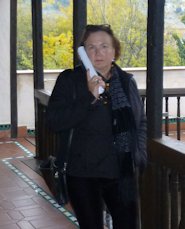 Dwight Peck's personal website Dwight Peck's personal website
A visit to Toledo (the other Toledo)
A getaway weekend to the ancient capital of Spain
You may not find this terribly rewarding unless you're included here, so this is a good time for casual and random browsers to turn back before they get too caught up in the sweep and majesty of the proceedings and can't let go.
The Tuesday Market, Lerma Palace, and the Alcàzar
    

Before we get really serious about our sightseeing, it's time for breakfast in the hotel.
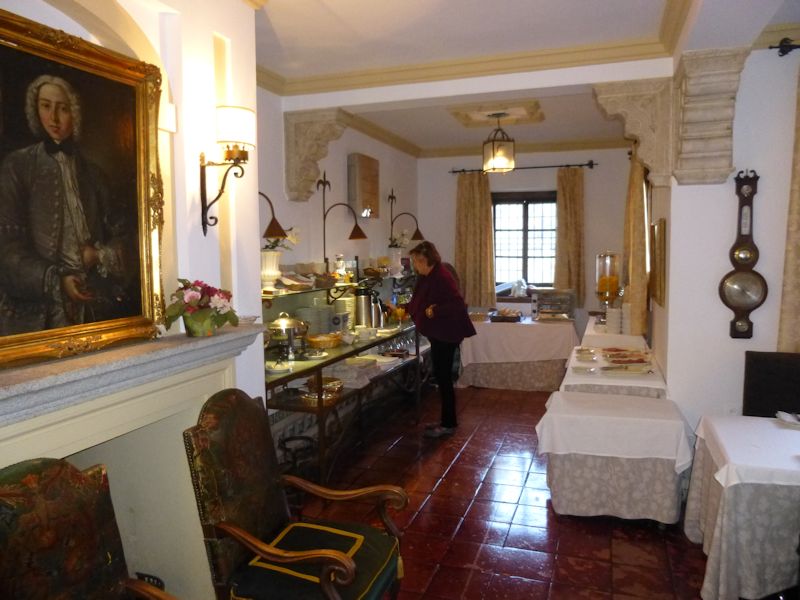
A good spread, leaning a bit towards the German tourist market (chopped up hotdogs along with the bacon), but plenty of it, à go go as the Swiss say for 'all you can eat'. Or ad libitum, as it might be.
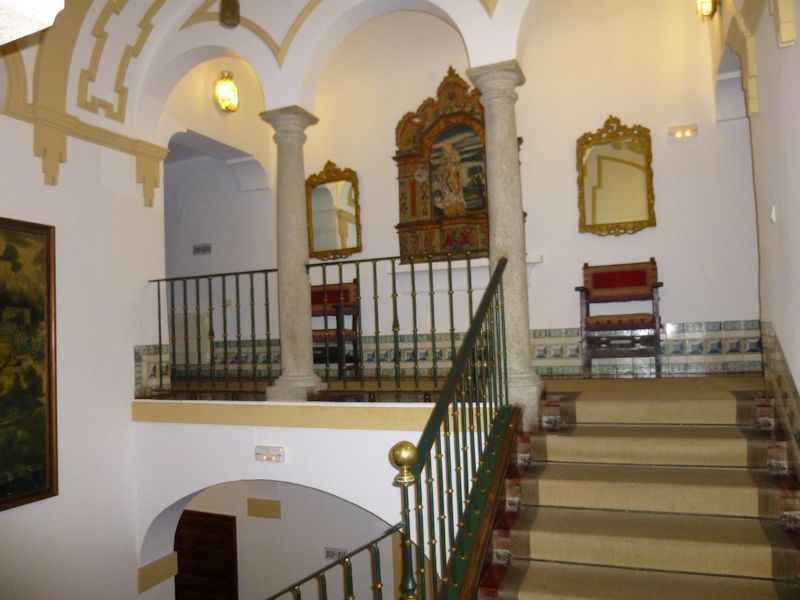
Cardinals must have lived fairly well back in the old days (and now, in the off-season, we can fake it ourselves)
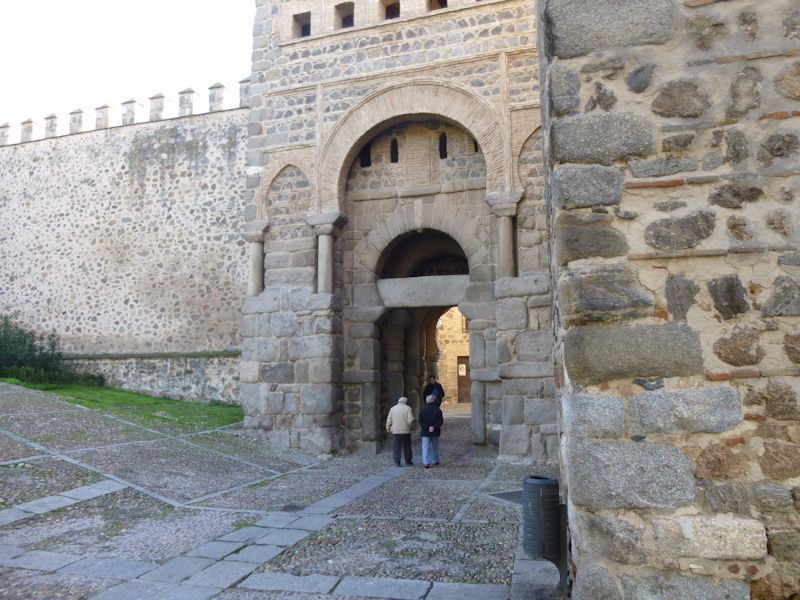
The Old Bisagra Gate (also called the Alfonso VI Gate since the king entered here when he conquered the city in 1085), just next to the Cardenal hotel; built earlier in the 11th century, it was the main city gate until the New Bisagra Gate was built just up the road in the 16th century.
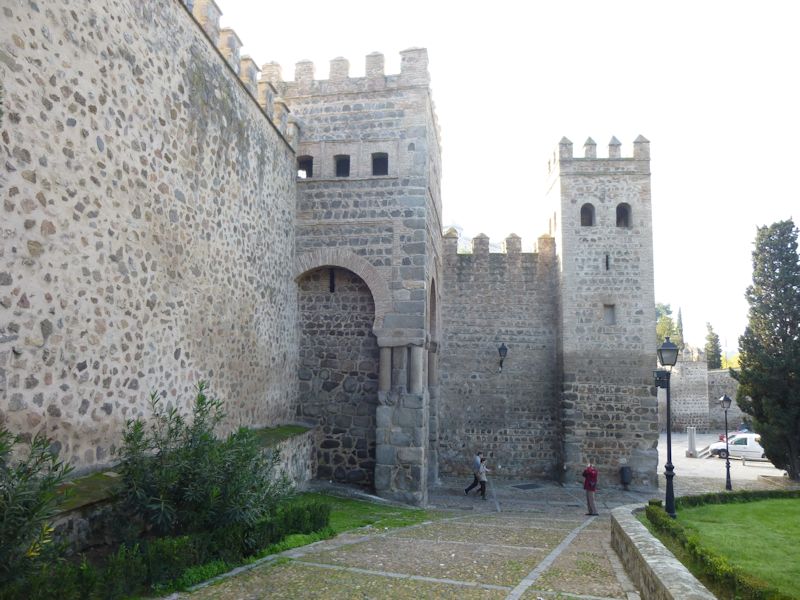
The Old Bisagra Gate
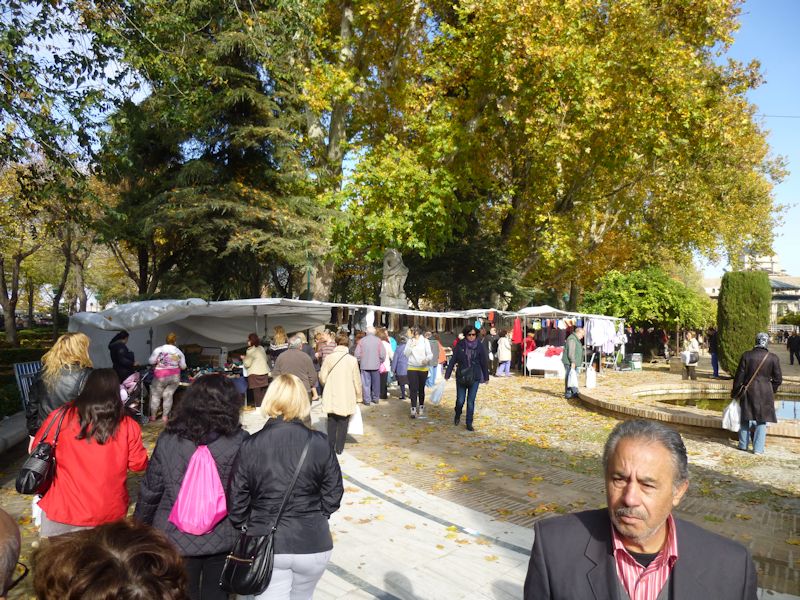
Just outside the main gate we're distracted by the Tuesday Market in the vast Parque de la Vega just north of the city walls.
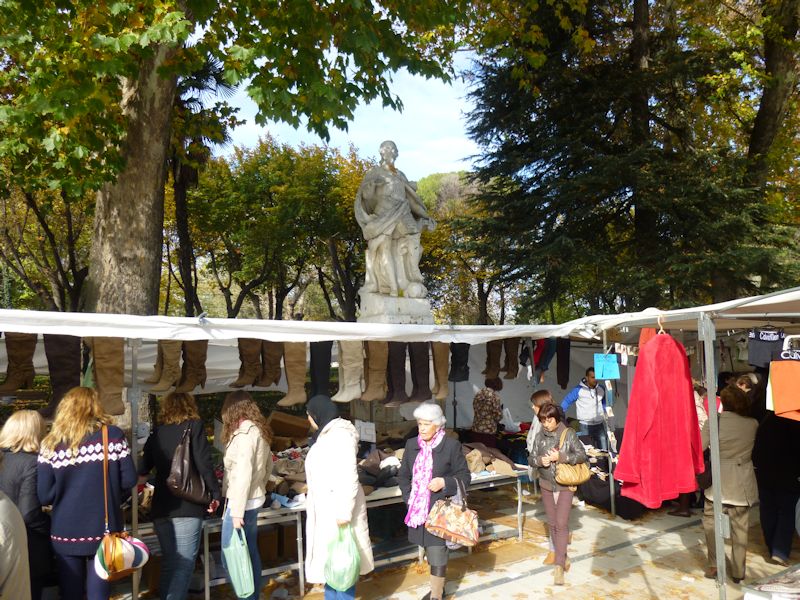
Brisk trade. Perhaps that's Garcilaso de la Vega his own self, the justly celebrated soldier/poet of the early 16th century, a native son of Toledo.
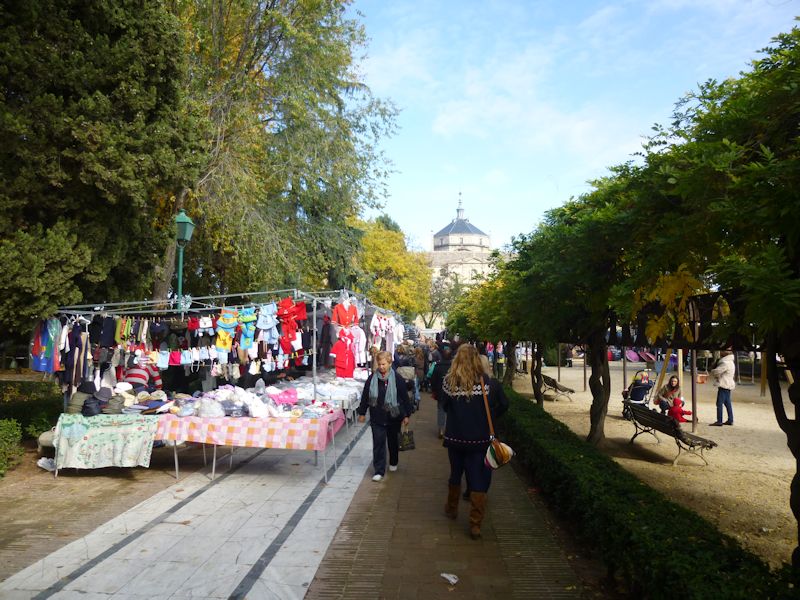
We all wonder at how the wonderful Spanish people can carry on with their lives under the assaults of the German and Wall Street bankers with their "austerity programmes", throwing many people out of work and reducing the rest of them to US-style Walmart pay scales. This is probably part of the answer.
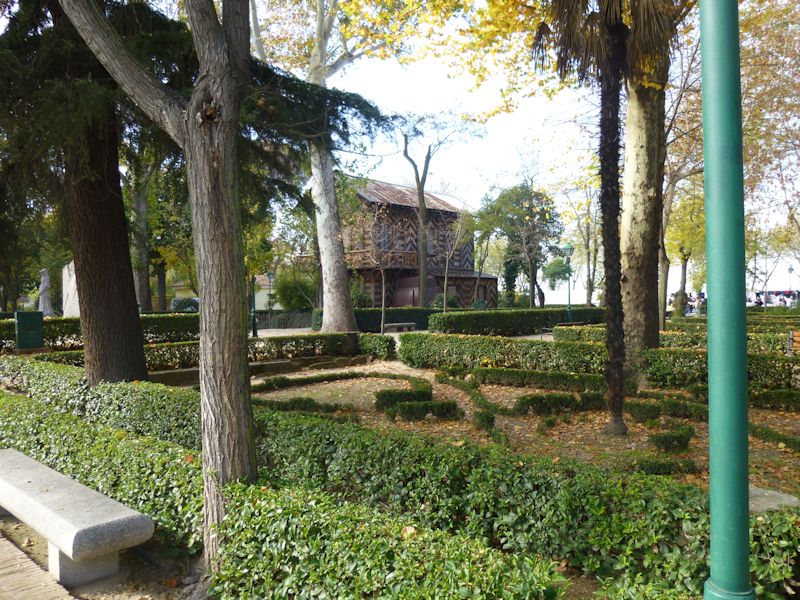
An old hunting lodge perhaps
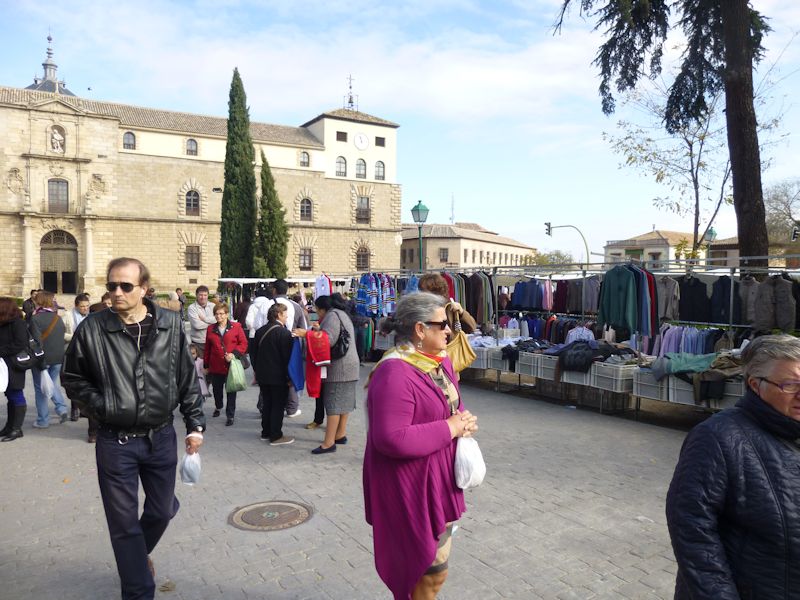
The informal economy -- how else to get round a formal economy run by and for Goldman Sachs and Angela Merkel's banking friends? The prices are rock-bottom and the goods mostly seem to be genuine brands and not knock-offs.
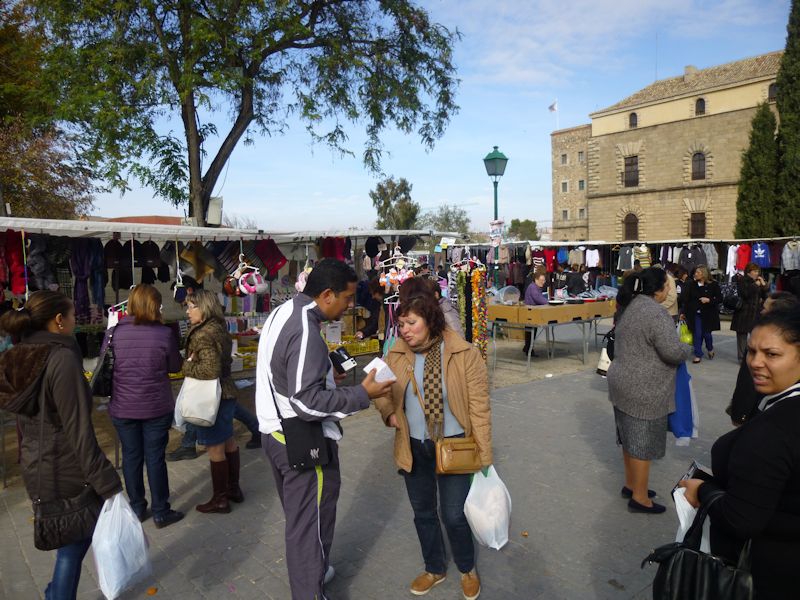
And all in the shadow of the Hospital de Tavera
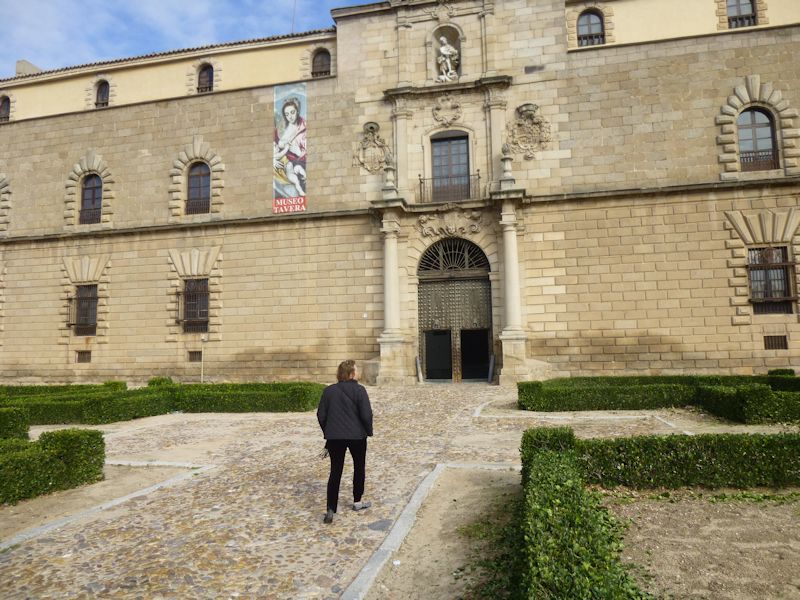
The Museo Tavera, or Museum of the Duchess of Lerma, just outside the old city walls
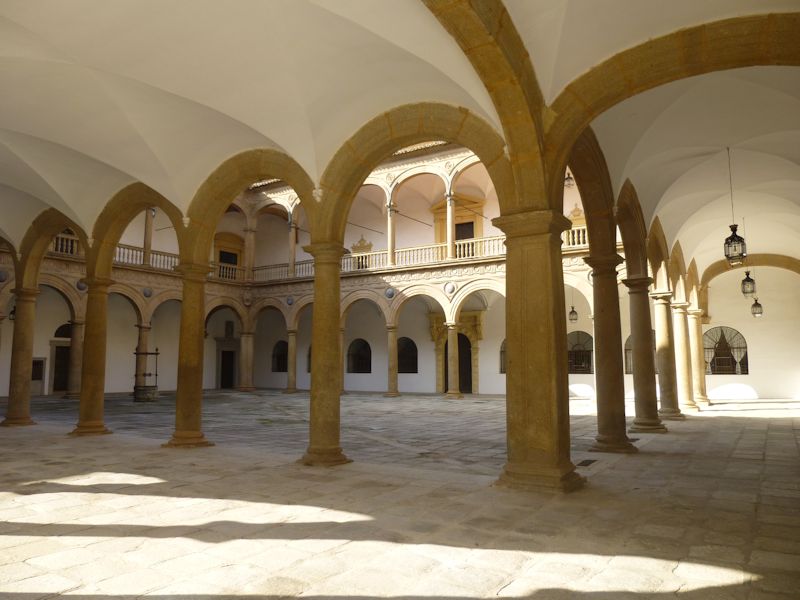
The Hospital of San Juan Bautista was built in the mid-16th century by order of the Cardinal Juan Pardo de Tavera, a noted humanitarian and also the Grand Inquisitor of Spain. (The altarpiece of the church was designed by El Greco.)

The crypt. The hospital and its church ended up in the hands of the venerable Medinaceli family, in later years sporting the ancient title of the great Dukes of Lerma. After the horrific battles in Toledo during the Spanish Civil War, the newly widowed Duchess of Lerma renovated a wing of the building as a palace and moved part of the family's art collection here. Like El Greco, of course, Ribera, Tintoretto, Luca Giordano of Naples, Titian, and the tour through the furnishings, including the ancient hospital archives, is brief but fabulous.
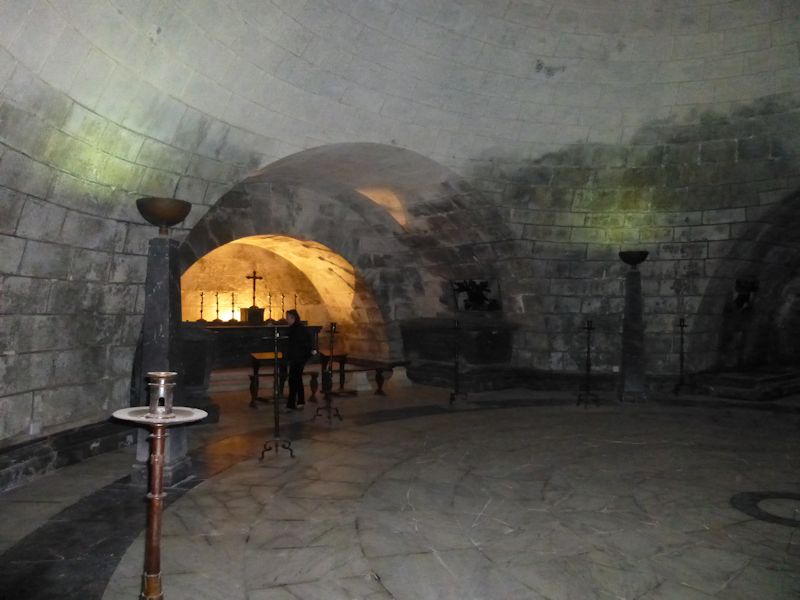
But the crypt is creepy! It has a fascist feel to it and, indeed, some of the sarcophagi belong to family members on the nationalist side in the Civil War. (If they'd been priests, they'd have been sainted by now.)
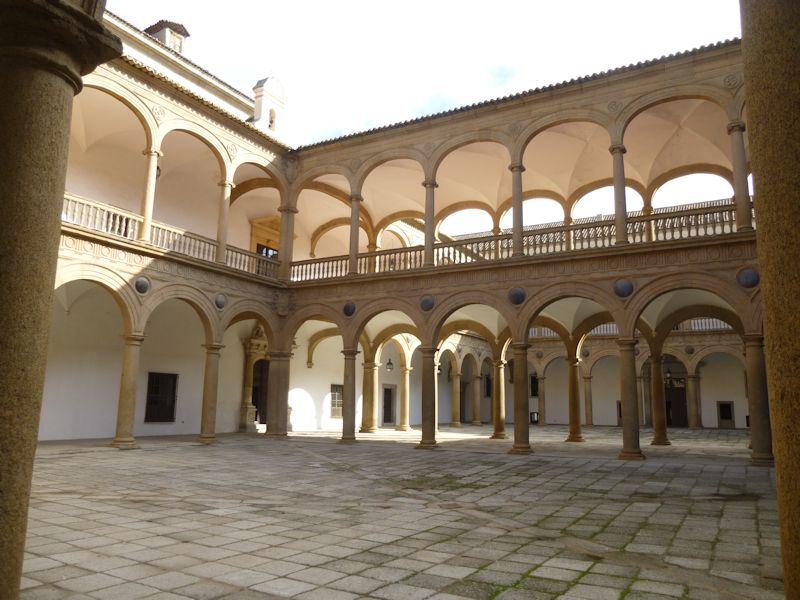
The patios are brilliant.

The hospital's well
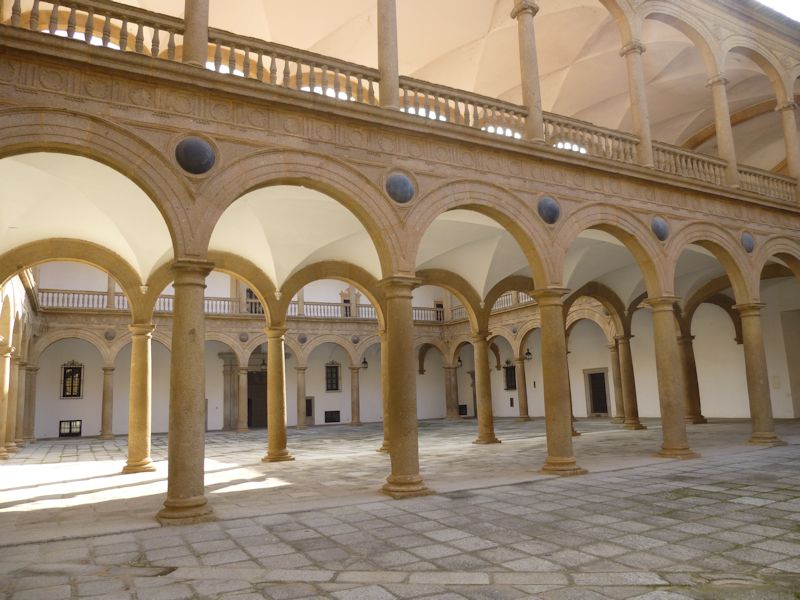
Patios
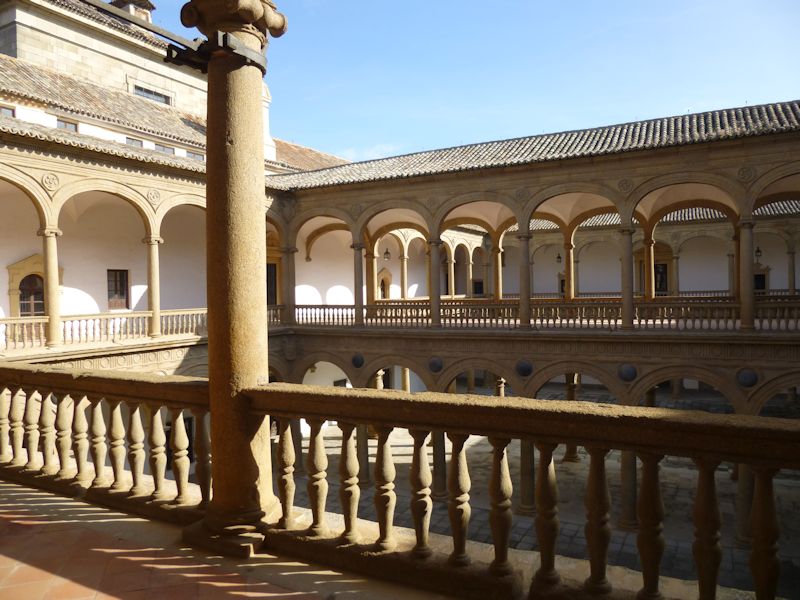
Up a level, following our guide through the old Duchess' elegant rooms
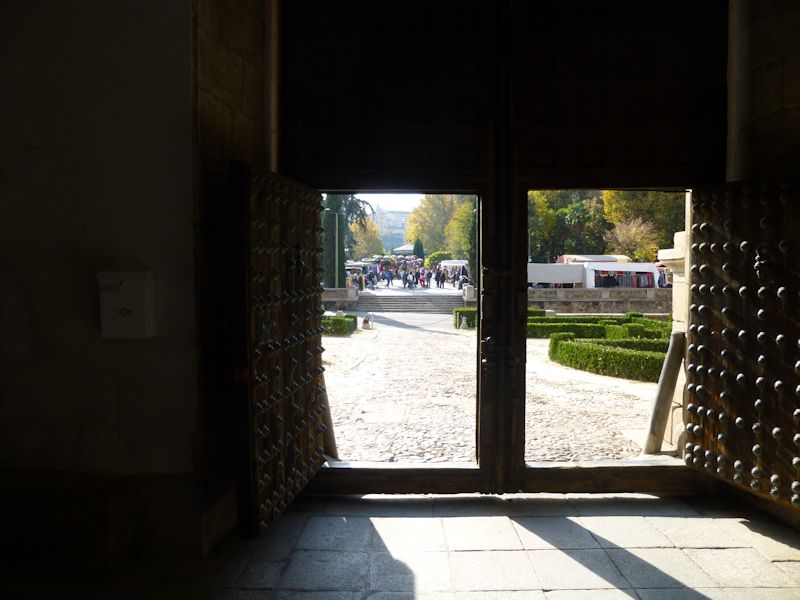
And then back out onto the street, and to the market across the way
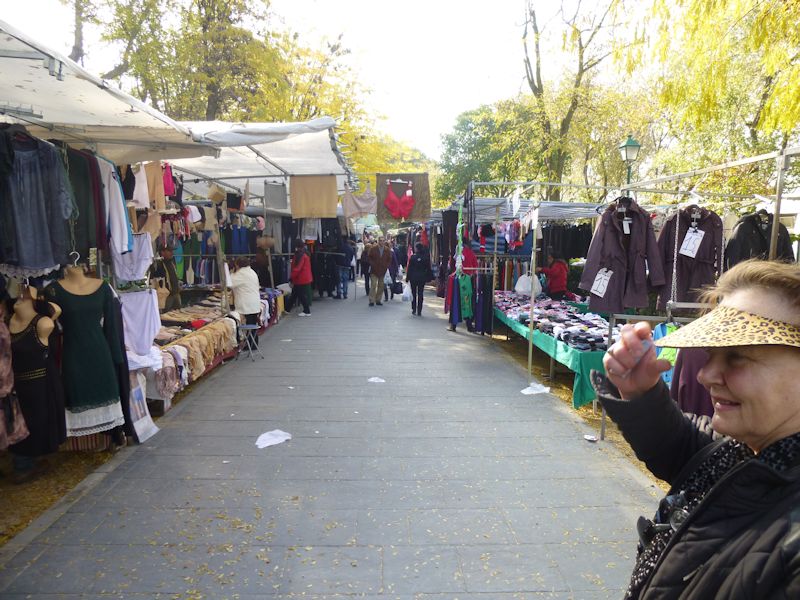
We're never going to get out of here without buying something, that's for sure; an unmissable bargain.
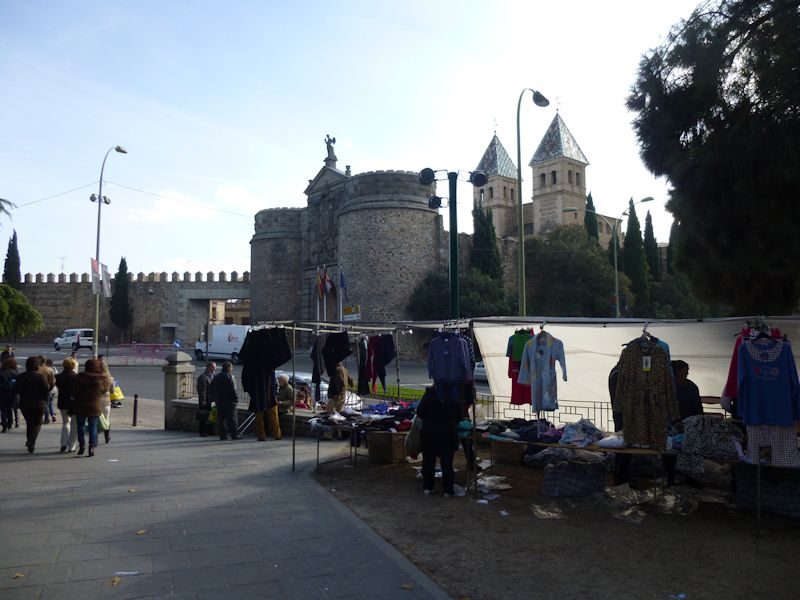
The present main gate of the city, the New Bisagra Gate, first constucted under the Taifa kings in the 11th century but in its present glory dating from the Emperor Charles V's time in the early 16th. The traffic presently flows round both sides of the central gate and towers.
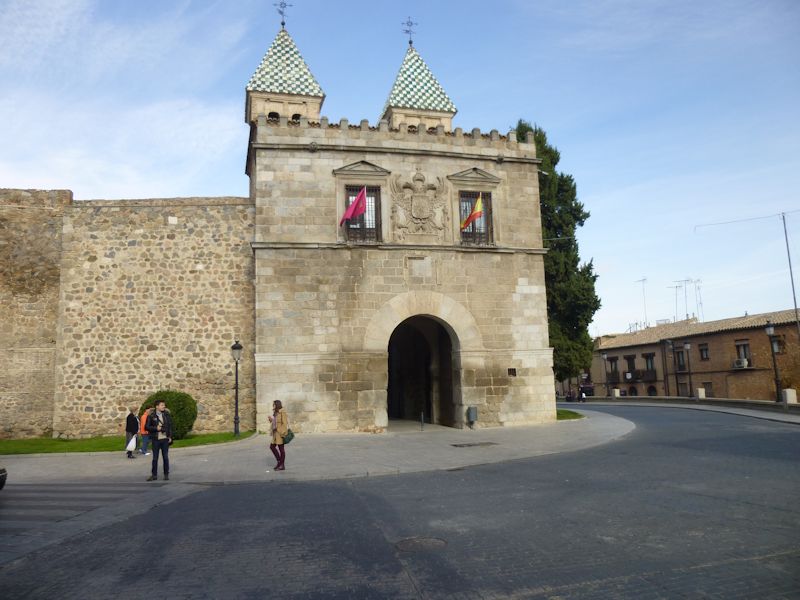
And this is the back of it; the Gate is a fortress in itself.

Inside the main gate, this is the main thoroughfare that winds up the hill to the city centre around the Plaza Zocodover and the Alcàzar fortress.
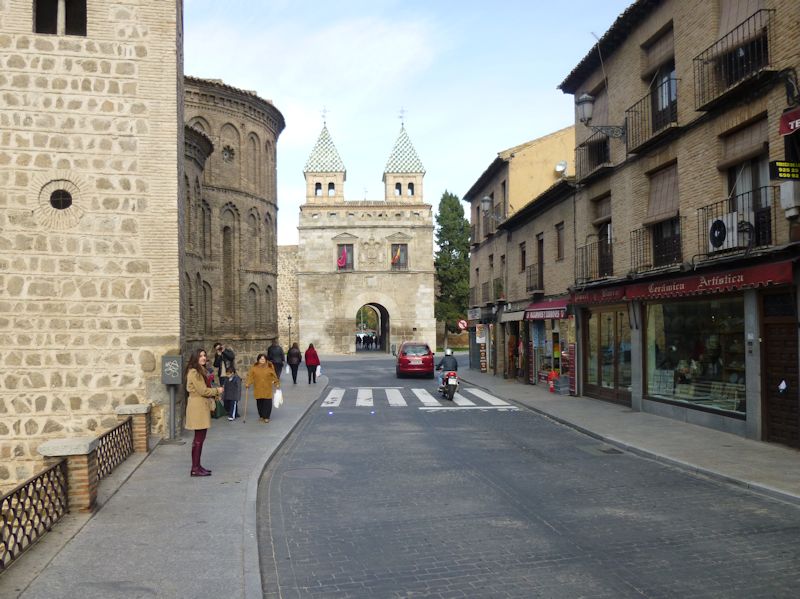
A look back at the back end of the Gate; this the most natural way into the city, terrain-wise -- into the 'Arrabal' neighborhood, inside the outer city walls but outside the really serious walls up the hill. The church on the left is the not-so-interesting Santiago del Arrabal.
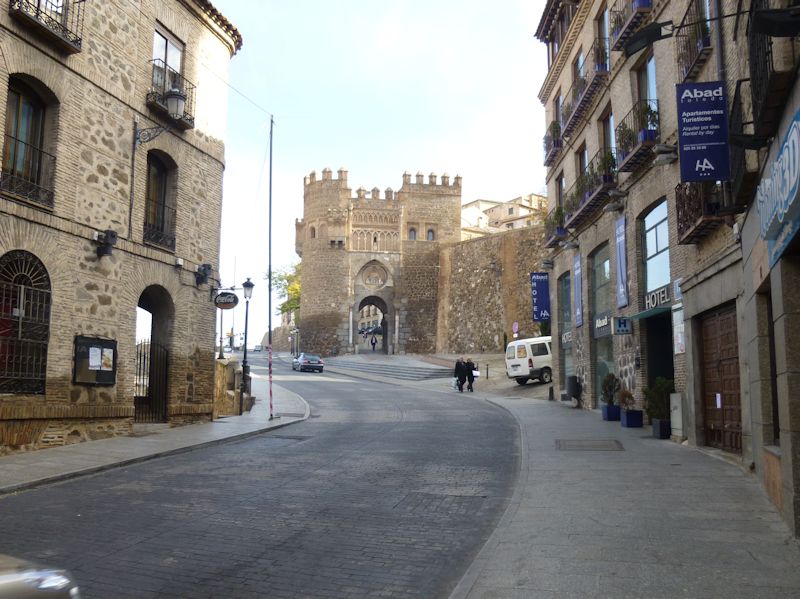
The modern road winds up to the left of the Mudéjar-style Puerta del Sol or Sun Gate just ahead -- that entrance to the city, in its turn, was built in the 14th century because the older Islamic-era Balmardón gate, straight up the hill behind the buildings on the right (a gate in which, two days later, we would have lunch) turned out to be impassable for wagons of the era.
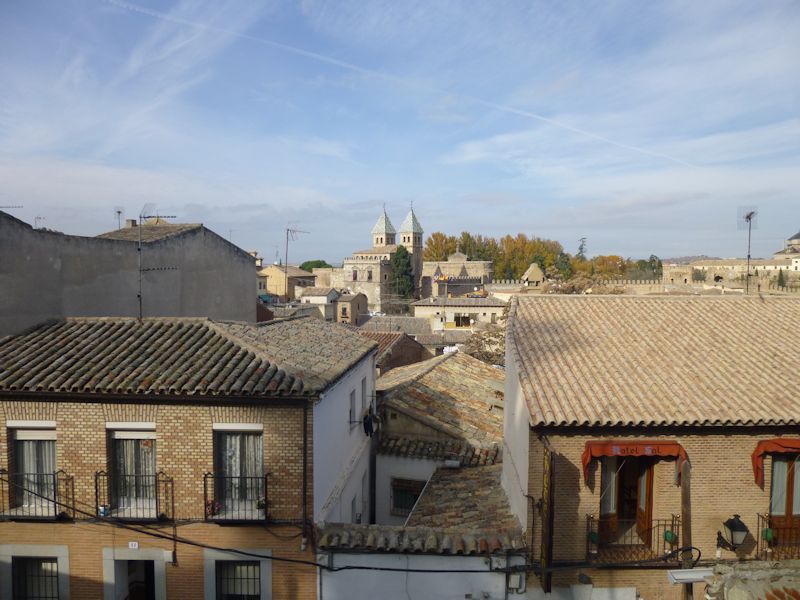
The rear of the Bisagra Gate from the roadway up the hill. The barrio below, outside the upper city walls but within the outer wall, is called the Antequeruela.
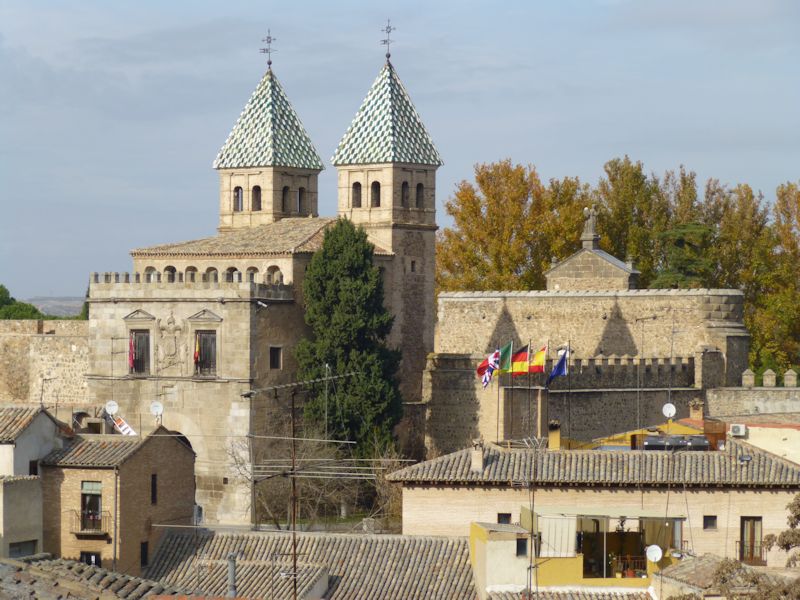
The Bisagra Gate complex
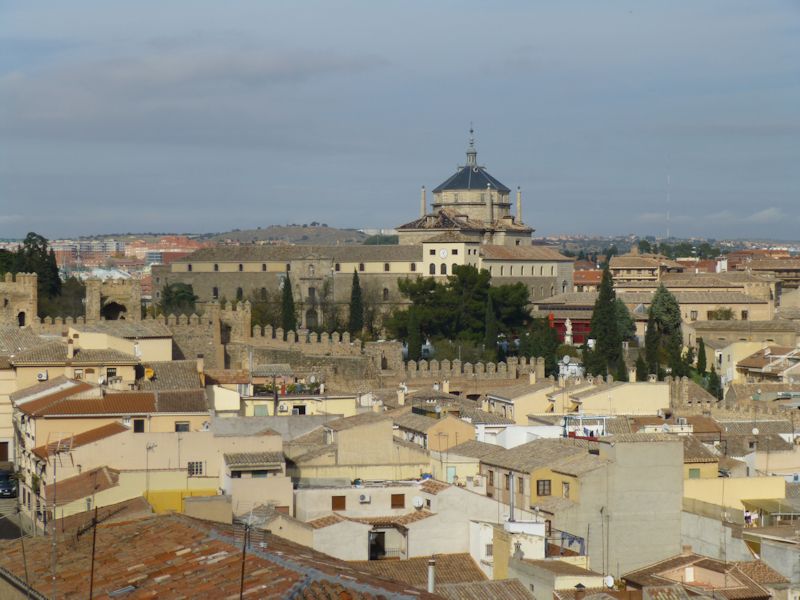
The church of San Juan Bautista and the Tavera hospital outside the walls
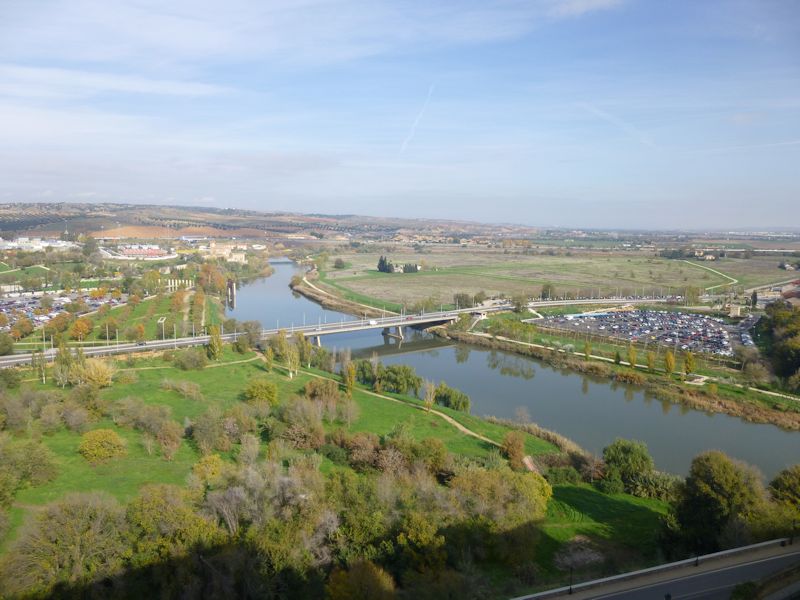
A view of the River Tajo from the esplanade of the modern convention centre halfway up the hill into the city; there are huge park-n-ride carparks on either side of the river.
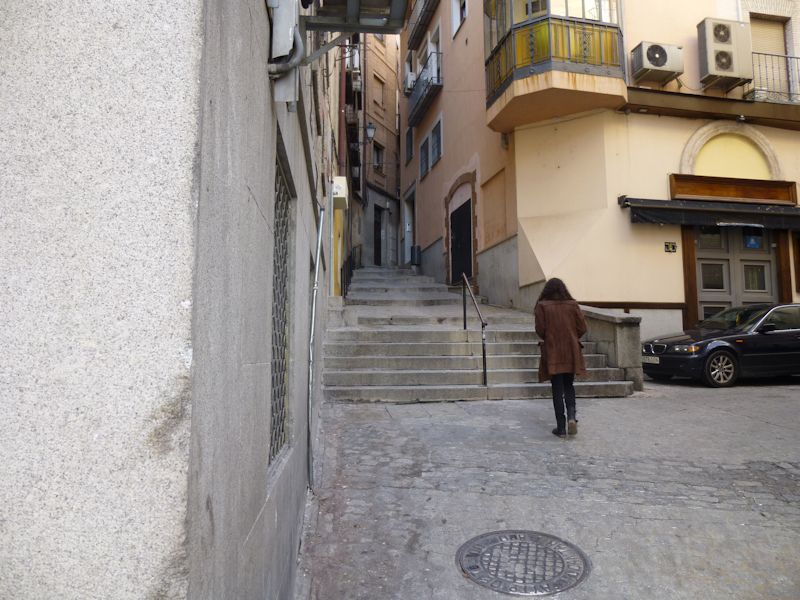
Farther up into the old town

The tourist train's headquarters is in the Plaza de Zocodover, the ancient livestock market, more or less the city centre adjacent to the Alcàzar.

This is probably a variant of the Dotto Trains 2x4 Euro 5 Muson River.
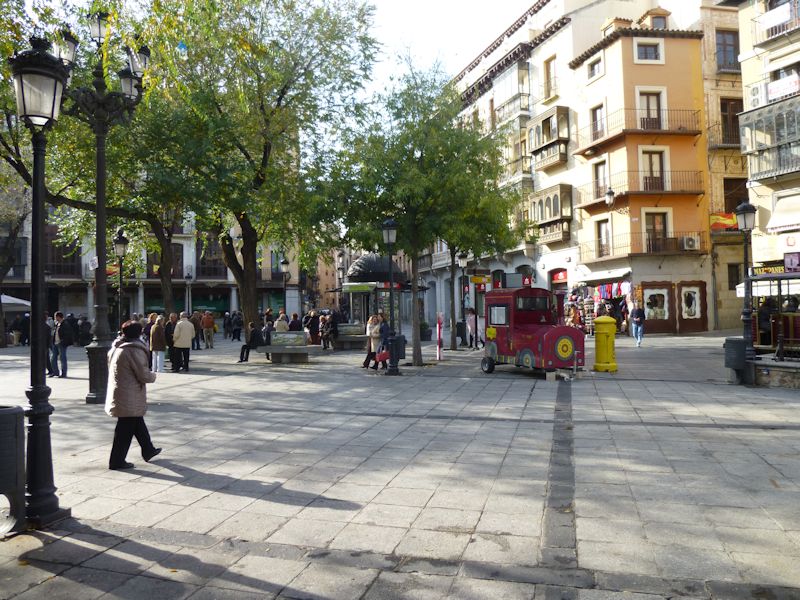
Plaza de Zocodover, a kind of city centre off to the side, next to the Alcàzar and Santa Cruz near the top of the hill -- an Arabic name indicating a livestock market and subsequently the setting for the Inquisition's autos-da-fé.
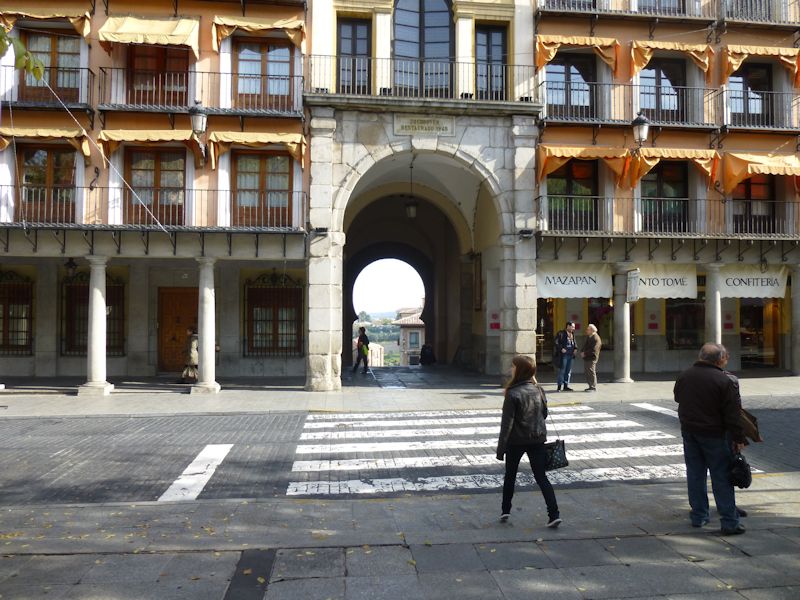
The Arch at Zocodover Square

Himself, waiting for lunch.
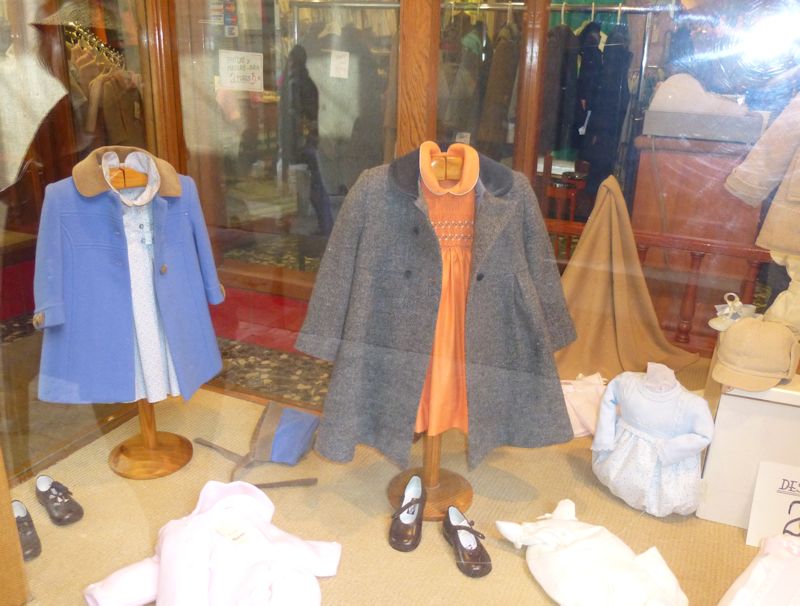
Reminds Kristin of her youth

The Plaza de la Magdalena

Here comes the train!
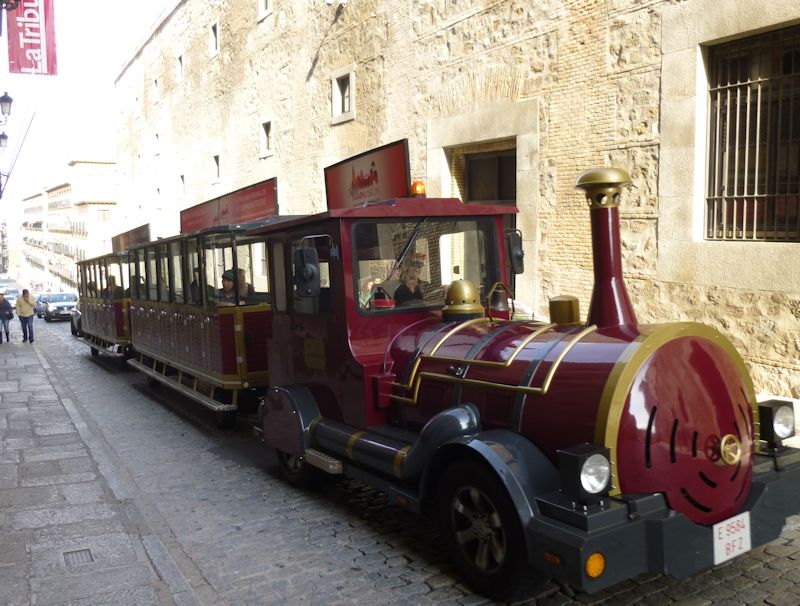
A big smile and a wave
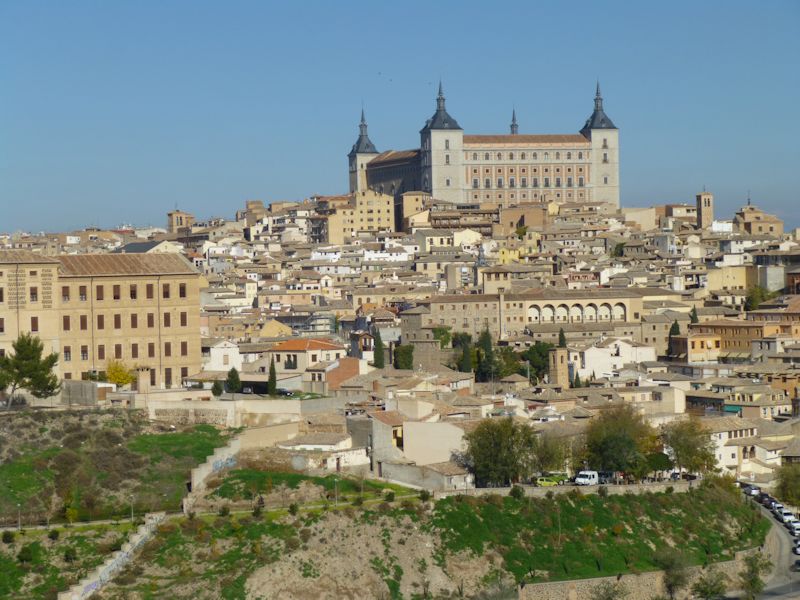
The Alcàzar, the ancient fortress/palace (seen from the far side of the river) -- it's imposing on the outside, and inside it's the Museo del Ejército, or Army Museum. The building, dating from time immemorial, was nearly destroyed by Napoleon's troops in 1810, as what wasn't?, and then badly damaged in the "Siege of the Alcàzar" in July-September 1936, when the Guardia Civil and local Nationalist notables held out successfully against the Republicans. But lovingly restored.
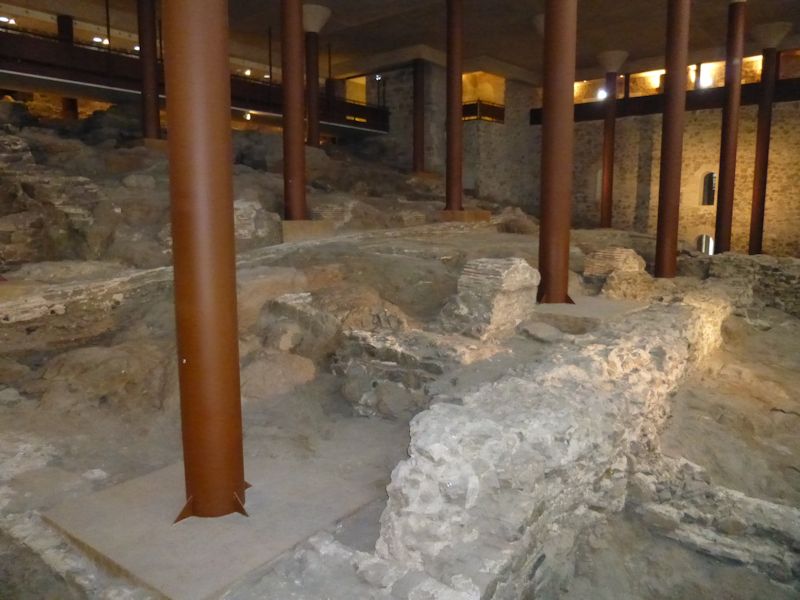
We're inside now: When they were building a modern building to front the museum, the work was held up for a year when they ran into Roman foundations.

You can't stop them unless you shoot them in the head.
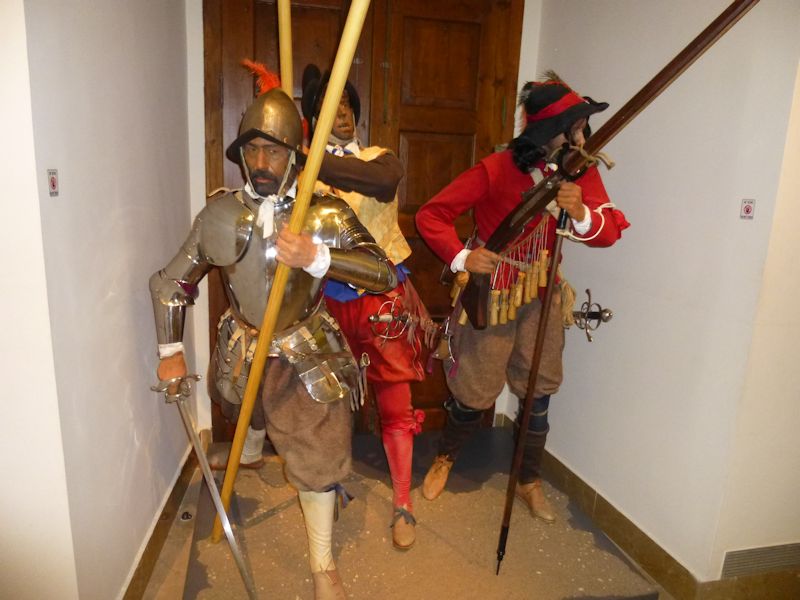
The museum is enormous and very well presented, mostly in Spanish and English, and it has a nice luncheon restaurant where Kristin waited for me!
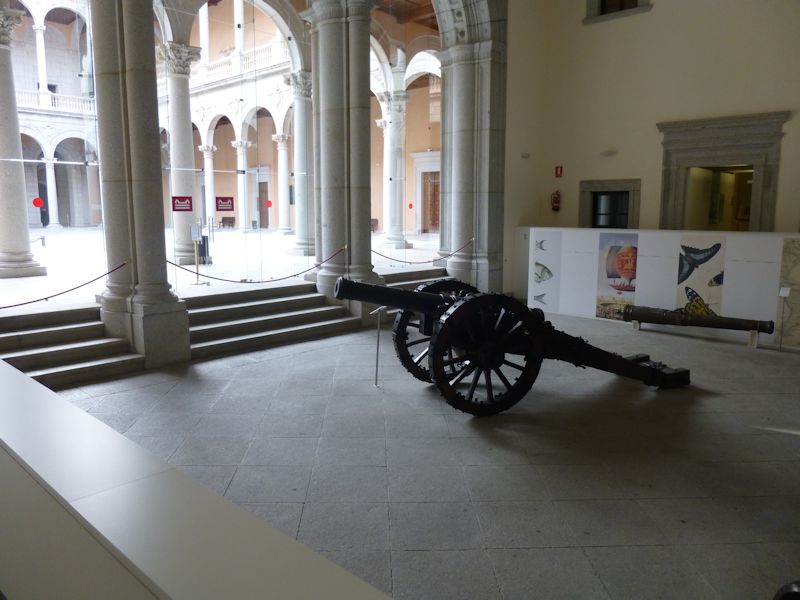
It's not exactly a military history museum -- it's the museum of the Spanish army. Which means quite a lot of military history as well as corridors full of bombastic 19th century uniforms and portraits of solemn army bureaucrats with muttonchop whiskers. (The sensitive era of the Spanish Civil War is deftly handled.)
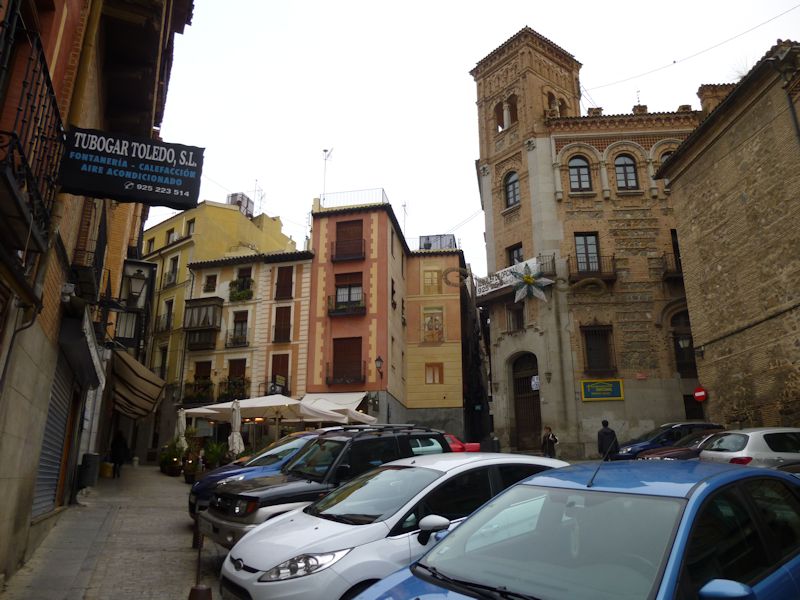
Back out on the street again: the Plaza de la Magdalena, one block over from the Alcàzar
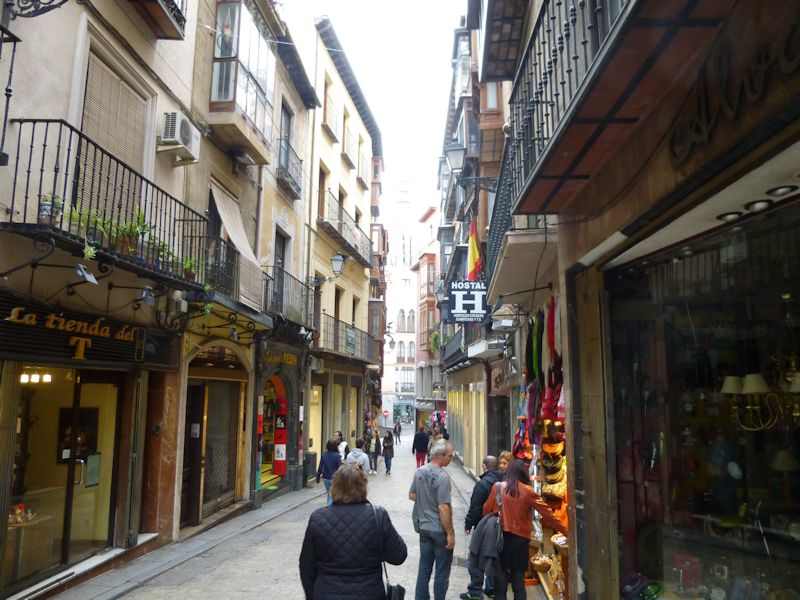
A shopping street leading to the cathedral
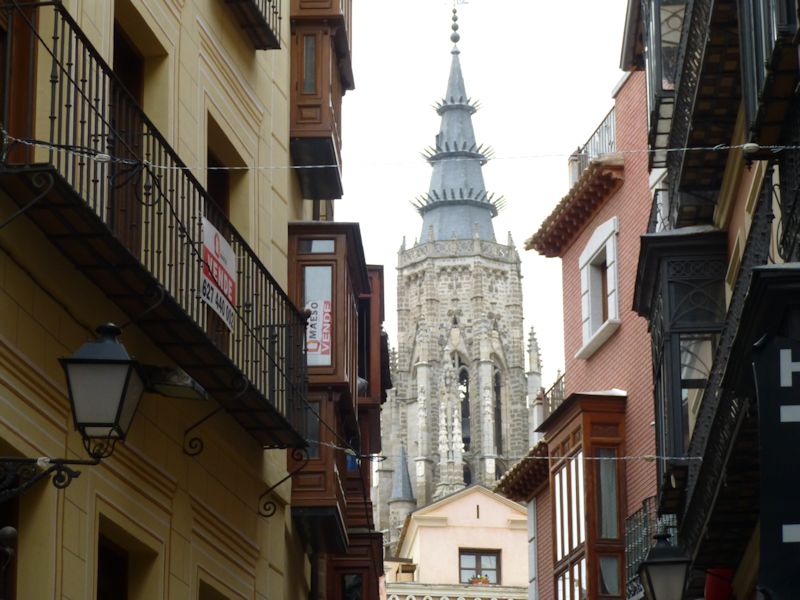
The cathedral belltower
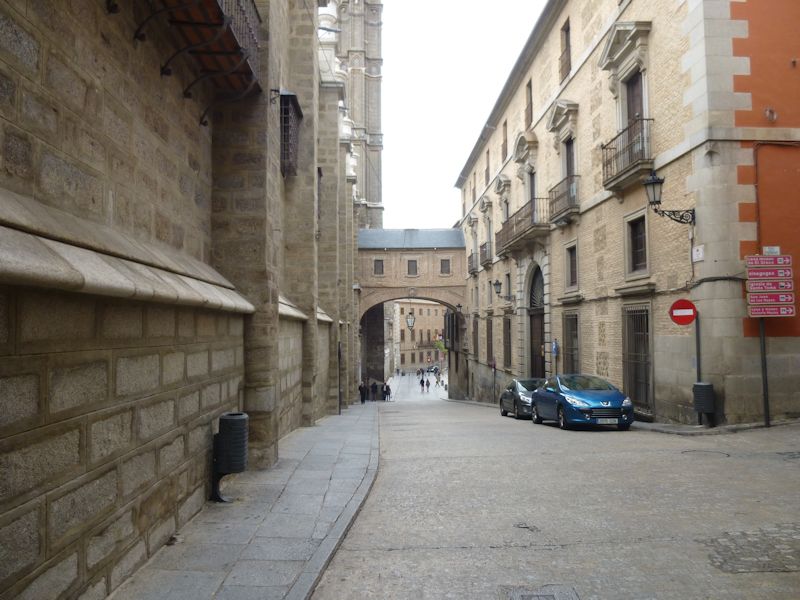
Near the cathedral
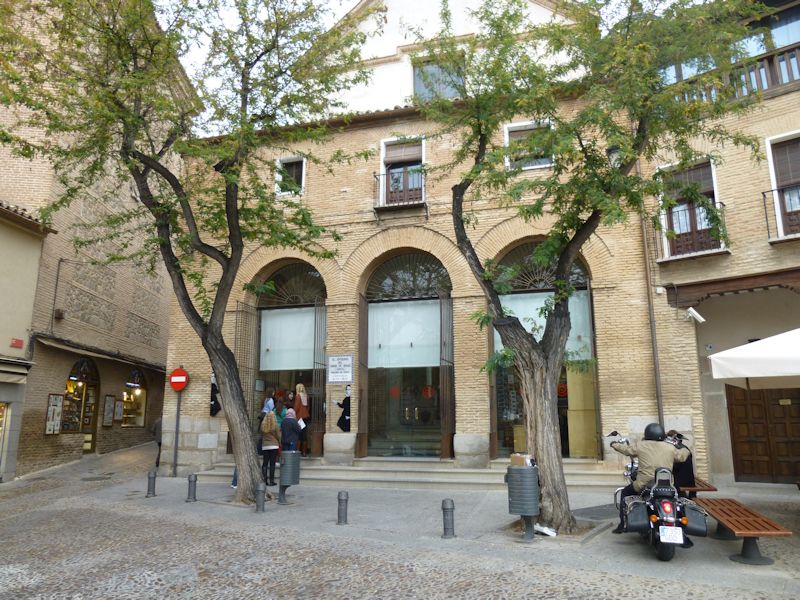
We're wandering about looking for the El Greco museum and we've somehow found ourselves here at the Church of Santo Tomé -- an unassuming spot, otherwise, but it's got El Greco's 1586 painting "The Burial of the Count of Orgaz", about which Kristin is enthusiastic and I am not and for which El Greco had to appeal to the Pope to get his agreed payment. ("No Photo!")
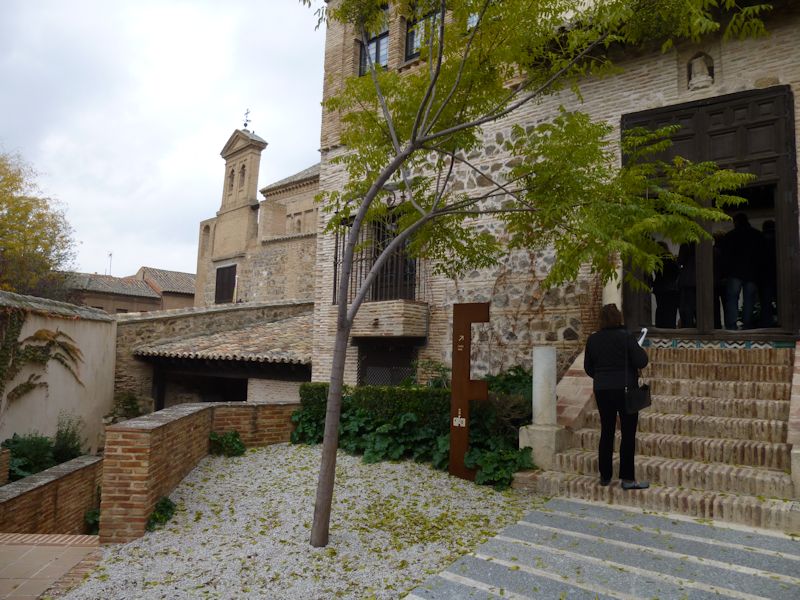
Just down the hill, this is the El Greco Museum, within its outer walls. Formerly called the "El Greco House".
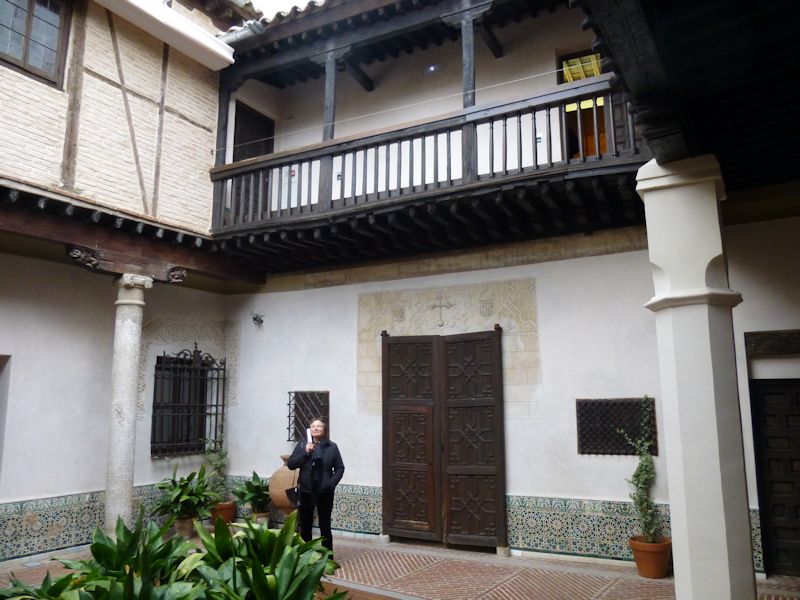
When El Greco's critical star began to rise in the late 19th century, a passionate early fan, the Marquis of Vega-Inclán, searched out the artist's original residence, renovated it, and furnished it as it might have been in El Greco's own time.
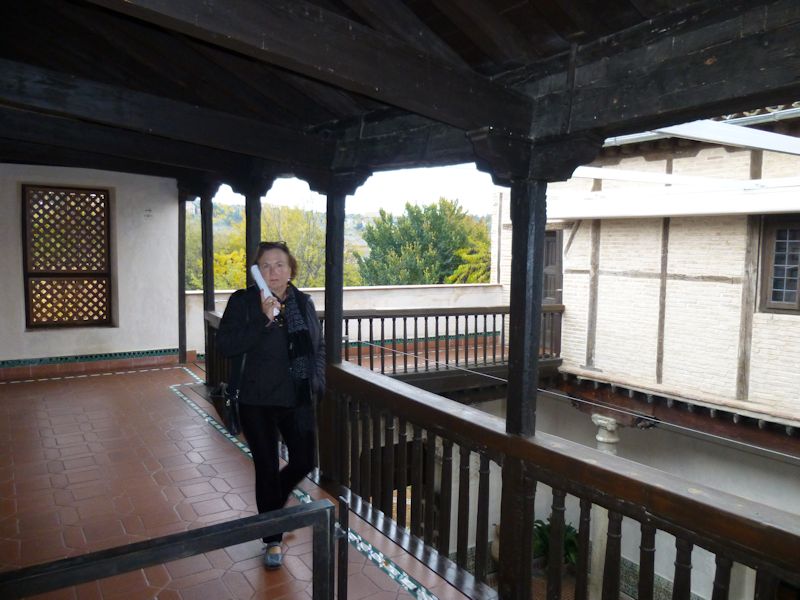
It turned out somewhat later that El Greco's house was actually across the street, but this is a marvelous recreation anyway, with a lot of the artist's own works and sophisticated interpretation facilities for explaining his evolution and technique, and into the bargain a pretty fascinating look at a well-appointed family house of the late 16th century.
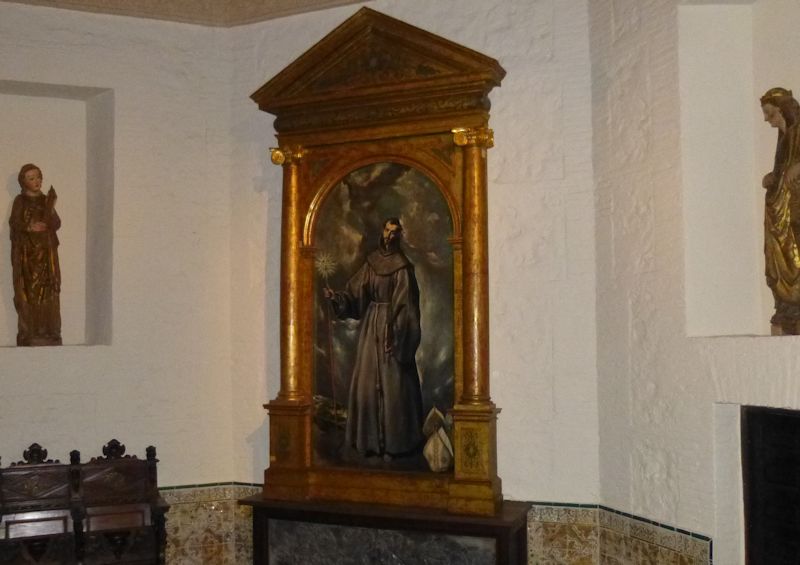
El Greco's St Bernardino of Siena, or the Hombre of the Long Neck; probably that astigmatism again.
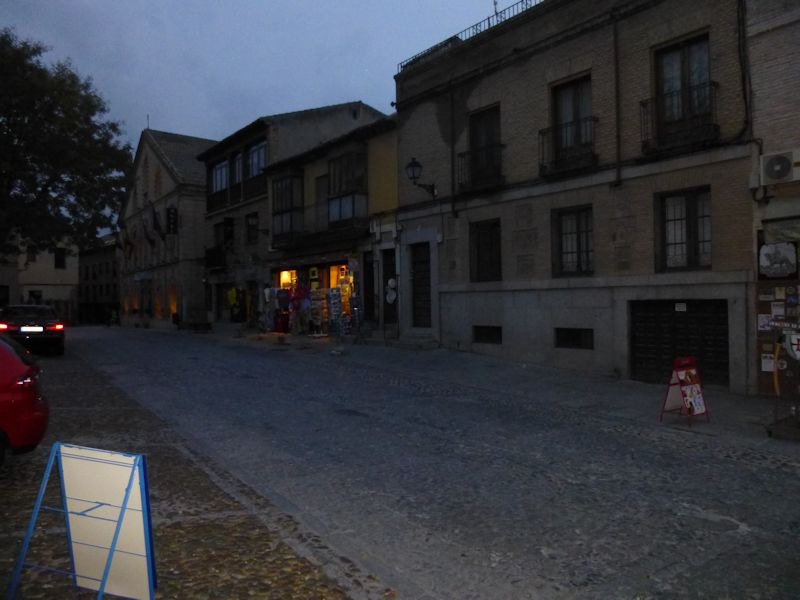
El Greco's house is in the Barrio Sefardi, or Judería, the flourishing Jewish quarter prior to the expulsion of the Jews from Spain under Ferdinand and Isabella in 1492.
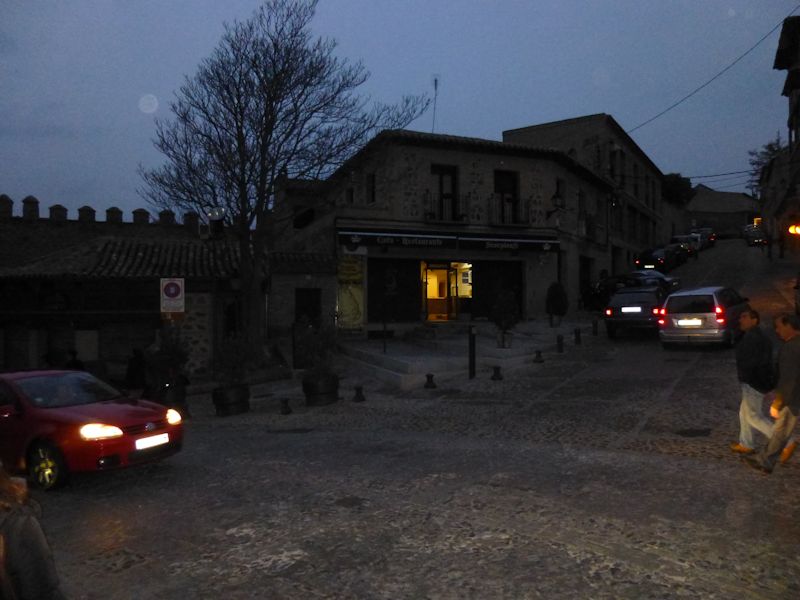
Just at dusk, we're on our way down the hill and out the Cambron Gate, the city's other main entrance, which gave access to the Jewish Quarter.
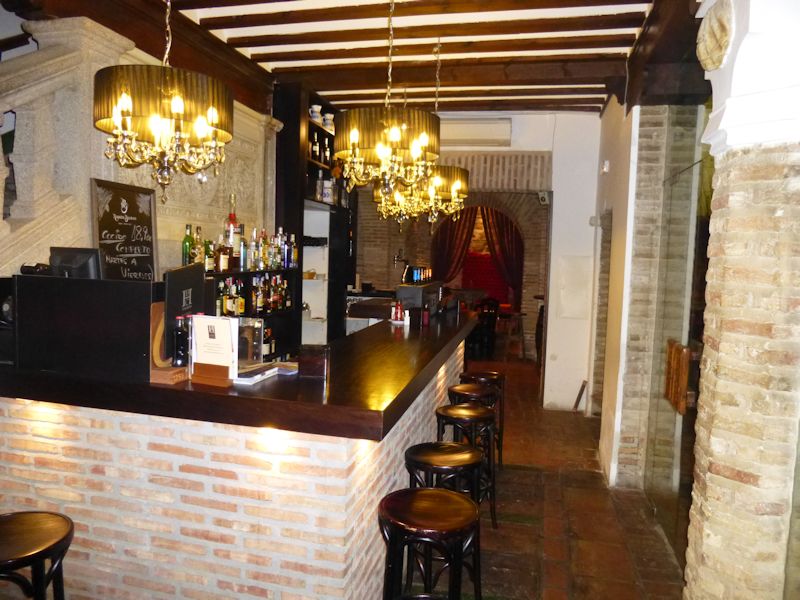
The pub in the hotel, the Taberna del Cardenal; we've stopped in for a quick one on the way back to the room.
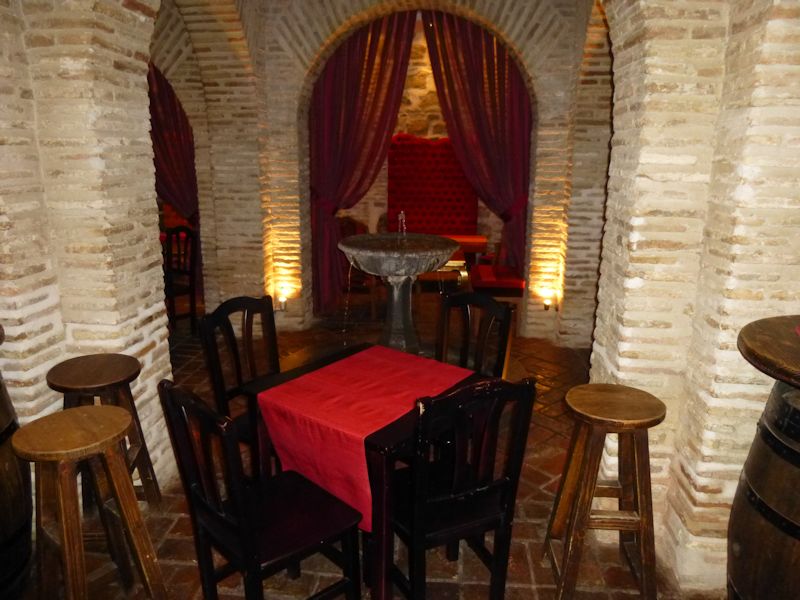
Amiable surroundings, but no staff showed up to pull the taps, so we bagged.
    
 Feedback
and suggestions are welcome if positive, resented if negative, Feedback
and suggestions are welcome if positive, resented if negative,  .
All rights reserved, all wrongs avenged. Posted 5 December 2012. .
All rights reserved, all wrongs avenged. Posted 5 December 2012.
|
 Dwight Peck's personal website
Dwight Peck's personal website
























































